
Feather Destructive Behavior - Finding Solutions
It is often stated that FDB becomes a habit. It is more helpful to realize that, over time, the behavior begins to have value to the parrot. If it did not, it would not continue. This recognition helps us to understand that a parrot will be more likely to give up this behavior if he learns that alternate behaviors bring greater reinforcement or enjoyment. For this, we can implement both short-term and long-term behavior modification strategies.The definition of FDB, a.k.a. feather picking, is any self-inflicted destruction of feathers. This may include pulling feathers out completely with the beak or feet, chewing them off at the body, barbering (snipping away small pieces), or shredding the barbules off of the central shaft. It does not include self-mutilation (chewing into the skin itself to create a wound). While feather destruction and self-mutilation can occur in the same individual, FDB does not necessarily lead to self-mutilation.
Enrichment
First, the environment must offer adequate opportunities for interaction. Many people tell me that their parrots won’t play with toys. My reaction? This can and must be changed. Lack of independent play behavior is one of the greatest risk factors for the development of FDB.
The first step is to provide enrichment items that elicit curiosity in the parrot and that offer a reward for interaction. Parrots especially like items that are easily destroyed or that offer ‘discovery’ (foraging) opportunities. If your parrot is one who prefers feathers to toys, you will likely need to experiment to find items that he is moved to investigate. Larger parrots sometimes prefer toys made for smaller birds. For others, projects created at home from paper and cardboard are of more interest. Luckily, many online stores now offer a wide variety of foraging toys.
Provide a variety of different ‘destroy and discover’ items to determine what piques your parrot’s interest. This might be something very simple in the beginning, such as a whole roll of white unscented toilet paper hung in the cage. This common item offers the same opportunity for ‘snipping’ as feathers do. A wonderful resource is Kris Porter’s Parrot Enrichment Activity Books, available for download free of charge at www.parrotenrichment.com. Try to provide something new each day to trigger curiosity. You will also need a variety of foot toys for the distraction technique described below.
Presenting a variety of treats and surprises in “puzzle feeders” (like this homemade one using plastic caps) or in rolls of paper, boxes and egg cartons, can provide wonderful opportunities for foraging and discovery. Birds quickly learn to view these new offerings with eager anticipation.

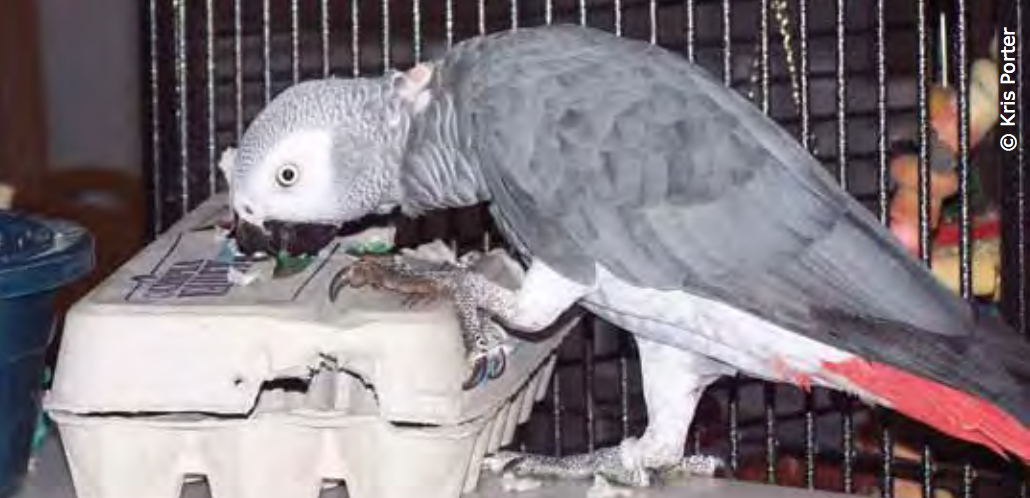
Distraction & Redirection
Any behavior that gets a reward will occur more often in the future. Therefore, if you are giving your parrot attention for chewing or pulling feathers, you are actually reinforcing this behavior. It is important to overtly and completely ignore the behavior.
The following distraction technique often helps to break down the behavior over time if implemented consistently:
• When you notice that your parrot is engaged in feather destruction, ostensibly ignore him, but create some sort of auditory or visual distraction, such as tapping a spoon against a pan. He should have no idea that this distraction is in any way related to his activities. Do not scare him; the goal is to get him to stop chewing feathers and look up to identify the cause of the interruption.
• As soon as he looks up, reinforce him with a verbal marker, such as “Good, Cleo!”
• Immediately approach him and offer him a small foot toy or other item of interest.
• If he takes the item and begins to play with it, praise him and walk away.
• If he takes it and drops it immediately, or will not take it at all, step him up and transfer him to another perch.
• Begin again…this method requires a consistent approach. If you are able to do this for long enough, you will effectively help to break his pattern.
Behavior Modification & Training
The parrot who entertains himself with his feathers is often a parrot who sits in one place all day and will not interact with enrichment items. By using positive reinforcement to teach new behaviors, you can increase ten-fold your chances of resolving the FDB.
Before beginning any training with your parrot, you must first identify reinforcers (rewards) that he highly values. Generally speaking, the best reinforcers are often food rewards, such as small pieces of nuts or seeds. If you don’t know what your parrot likes, you can perform a ‘treat interview.’ Identify 5 to 7 different treats that you think he might value and that would be convenient to keep handy in your pocket. Place a small piece of each into a dish and offer this at a time when he’s hungry. Watch to see what he chooses first, second and third. These then become your training treats. Do not offer them at any other time.
Teaching Your Parrot to Play
Once you have provided plenty of new things in and on the cage and in any other areas where your parrot spends time, you will need to watch for opportunities to reward any interest he shows in them. Don’t watch him like a hawk, but remain aware of his activities. To do so, his cage will need to be located in your living area. If your parrot lives in a bird room, you will not have enough opportunities to reward the desirable behaviors he displays. When he shows any interest at all in one of the enrichment items, respond immediately with a “Good!” and walk over to offer one of your food treats. He will soon learn that interacting with the toys you have provided earns him a highly valued reward. In the beginning you may have to reward just sitting next to a toy, but you can gradually increase the criteria for earning a treat to including some form of interaction. If you have done a good job of providing interesting items, he will soon learn that interacting with them brings its own rewards.
Foot toys are small and intriguing for parrots to hold in their foot and investigate. A myriad of styles are available for purchase (left) or make your own like this one (right) made from drinking straws.
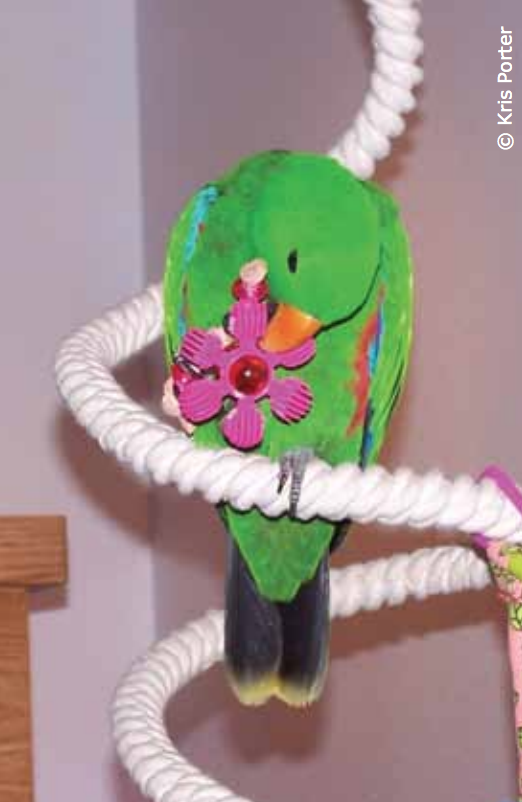
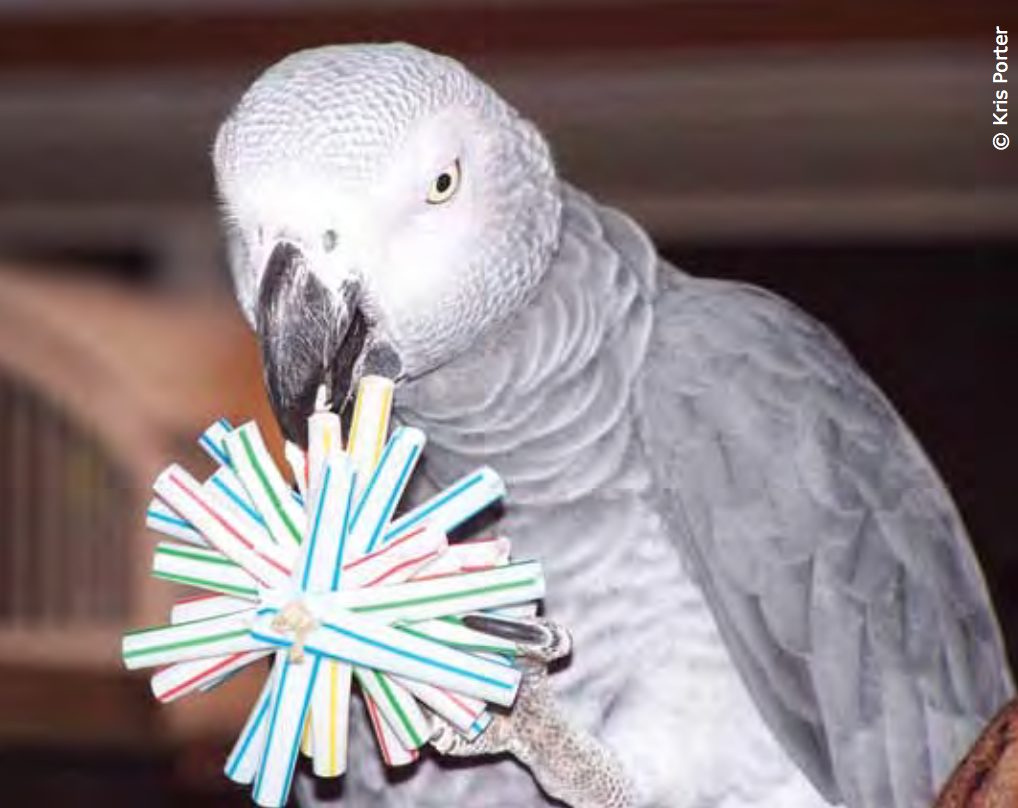
Rewarding Cued Behaviors
We often expect our parrots to step up or return to their cages just because we ask them to. In truth, these are behaviors that we should be rewarding. When we don’t, compliance often diminishes over time. When working with a parrot who damages his feathers, we shouldn’t overlook opportunities just to reward these cued behaviors. When you ask him to step up and he does, tell him “Good!” and offer a small treat or head scratch, if that’s what he prefers. Do the same when asking him to step back off of you, especially if he’s stepping off of your shoulder onto your hand – a behavior that many parrots resist. When you return him to his cage, offer a treat. If this is something that he doesn’t want to do, make sure that the value of your treat is a little higher. This simple practice will cause him to look to you for guidance and reinforcement and will set the stage for teaching new behaviors.
Teaching New Behaviors
Our intelligent parrots need learning opportunities for greatest psychological health. By teaching new behaviors, you accomplish three important things. First, if your parrot is one who has developed a pair bond with you, this practice will help to evolve your bond into a more appropriate one. Parrots offer the behaviors that make the most sense within the context of the bond they have with you. If your parrot has a pair bond with you, he will offer the behaviors that make sense within that context, such as regurgitation.
If you interact with him as a teacher, he will begin slowly to offer more behaviors that make sense within that context. Second, he will become more alert, oriented outwardly to the environment, as he learns that he has increased opportunities for earning the things he likes. Third, the new behaviors you teach will help to gradually replace the feather damaging behaviors.
As you decide what to teach first, you can consider both trick training and husbandry training. As the number of parrots doing tricks on YouTube can attest, many caregivers have discovered just how much fun trick training can be. This type of training need only take five to ten minutes a day of your time. Best results will be obtained by teaching a simple behavior, like targeting, first (targeting is simply the act of touching the beak to an object). By focusing first on a simple behavior, you allow the parrot to become familiar with the process of learning in this manner. It will also allow you to better perfect your timing and technique before you go on to teach something more complex. Many excellent resources are now available to help you get started. Jenny Drummey offers helpful training videos free of charge at www.projectparrot.com. Barbara Heidenreich’s excellent training DVDs and book can be purchased at www. parrots.org. Once you have taught targeting, you can use this skill to teach other behaviors, such as turning around or going into a carrier on cue.
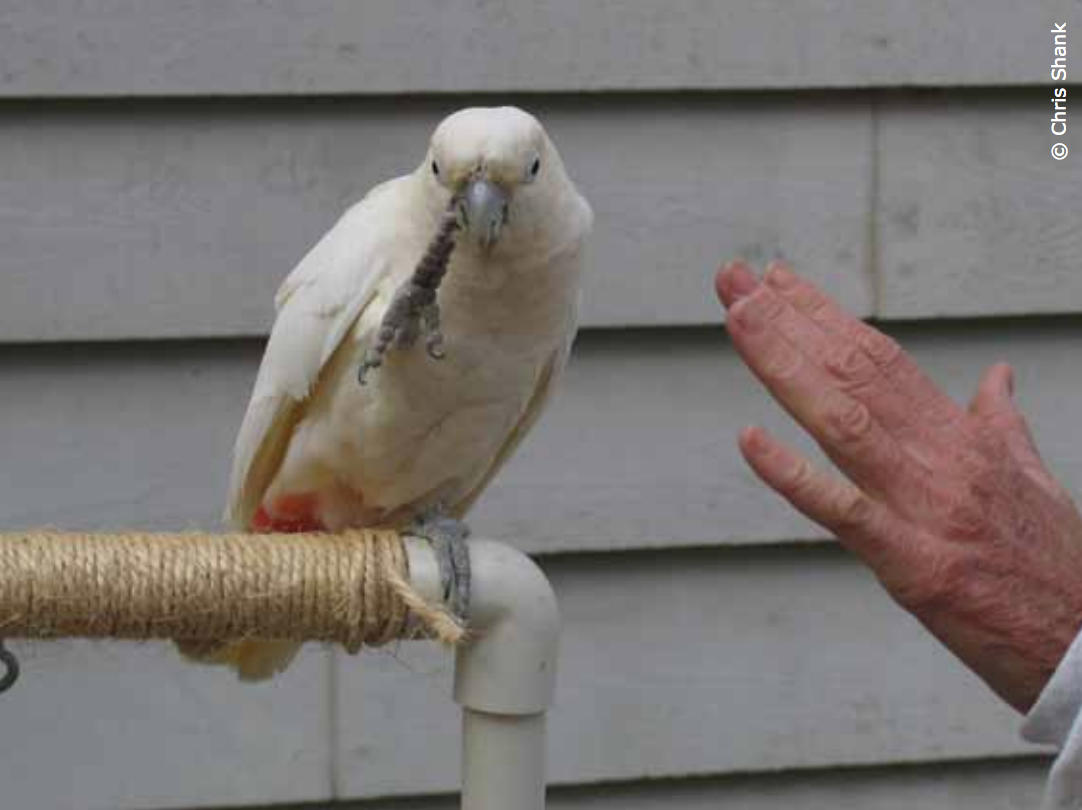
Offering your parrot the opportunity to learn new behaviors has significant benefits for both of you. From tricks like a wave to husbandry behaviors like entering a carrier, training is another tool that can significantly reduce problem behaviors like destroying feathers.
Teaching Husbandry Behaviors
Teaching husbandry behaviors is another way to expand your parrot’s horizons and make his care easier at the same time. Ideas include teaching him to take a shower, wear a harness, allow his nails to be filed, or go into a carrier when asked. Begin by assessing your parrot’s skills. What do you wish you could do with him that you can’t do now?
Often, this type of training must begin with desensitization – first allowing him to get used to the sight of whatever it is you are introducing. If you want to teach him to take a shower in the bathroom, you might first have to get him used just to being in there, or to teach him to step down onto the shower perch. Carrier training might begin first just with bringing it into the room and letting him get used to looking at it. Teaching him to accept a nail file or harness might begin with pairing treats with each of these items. Decide what you want to teach and then break this down into small steps. If you need personal help, identify a professional who has hands-on experience with training who can consult with you by telephone.
Feather destructive behavior is a problem that can be resolved. Even if a full resolution of the problem eludes you, by taking the steps outlined in parts one and two of this article, you will improve your parrot’s quality of life. Begin by ruling out medical causes by scheduling a visit with an avian vet who has experience with the problem. Next evaluate diet, sources of stress, and triggers for reproductive hormones, making changes where indicated.
Increase opportunities for bathing, exercise, and access to a safe outdoor enclosure. Make sure your parrot is getting adequate rest. Discover the types of things that interest him and provide daily enrichment. Lastly, discover the power of positive reinforcement to change existing behaviors. Reward your parrot for interacting with toys or performing the behaviors you request. Enrich his life by teaching him something new. If the changes you need to make seem too difficult, contact a professional experienced with this problem who can help you to work through these steps.
Do you remember Cleo, the African Grey? Her caregiver, beset with personal difficulties, struggled with making the necessary changes to her care and she continued to damage her feathers until she went to her second home. Her new owner improved her diet, eliminating all the snack food she had previously enjoyed and taught her to eat a high-quality pellet supplemented with fresh vegetables. She also taught her to bathe and to interact with enrichment items. After three years, her new owner wrote the following: “Even though you had told me that it was possible that Cleo might stop mutilating her feathers in a new environment, I never expected such a stunning turnaround. It’s been a gradual process; at times it seemed like she was taking two steps forward and one step backward, but the overall progress is there to see in the photo log we’ve kept.” I include this example as proof that this problem can resolve through steady and consistent effort. What are you waiting for?
Page 2 of 2
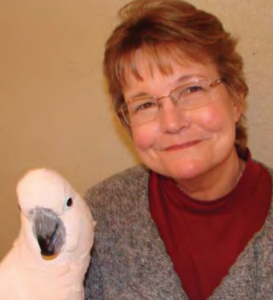
Pamela Clark (CVT) is a well-known author, speaker, and parrot behaviour consultant whose experience with parrots dates back over 45 years to the purchase of her first pair of lovebirds. Her special interests include feather destructive behaviour, training, flight and nutrition.
This article was originally published November 2011 in PsittaScene magazine.
© Copyright 2018 World Parrot Trust. All rights reserved.